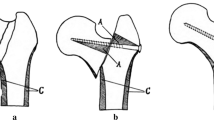Summary
The mechanical conditions for good fracture union, e. g., exact reposition and absolute stabilization permitting physiotherapy, can be provided only surgically. As the frequency of refractures after compression plate osteosynthesis indicates, the morphologically satisfactory consolidation of the gap with angiogenic bone which occurs with modern methods fails to provide sufficient resistance to stress. This reduced resistance is due to the fact that, in contrast to medullary nailing, any strain is absorbed by the externally mounted plate instead of by the bone. A nonphysiologic restructuring of the bone follows, directed toward the plate because of the abnormal functional adaptation. The usual fracture healing involving a callus spindle shows considerably better mechanical resistance, resulting from increased cross sectional area. The theoretical results are corroborated in experiments using optical stress models and documented with photographs.
Zusammenfassung
Die Vorteile der modernen Osteosyntheseverfahren wie z. B. die der Druckplattenosteosynthese (DPO) haben in den letzten Jahren die konservative Frakturbehandlung in ihrer klinischen Bedeutung zurückgedrängt. Die mit der DPO erreichbare callusfreie Überbrückung des Frakturspaltes mit angiogenem Knochen stellt morphologisch gesehen den Idealfall einer Knochenbruchheilung dar. Wie Minische Ergebnisse zeigen, wird die primäre Knochenbruchheilung hierbei jedoch hinsichtlich ihrer mechanischen Belastbarkeit gewöhnlich überschätzt. Demgegenüber erscheint die durch Callus bei ungestörtem Heilverlauf konsolidierte Fraktur belastungsfähiger. So traten Refrakturen in unserem Marburger Krankengut zwischen 1961 und 1971 nach Marknagelung nur in 1,57 %, nach Druckplattenosteosynthesen bei Schaftfrakturen in 8,7 % der Fälle, d. h. rund 5mal hüger auf.
Der Hauptgrund für die Minderbelastbarkeit des angiogenen Knochens nach erreicht wird.
Similar content being viewed by others
Author information
Authors and Affiliations
Rights and permissions
About this article
Cite this article
Köbler, H. 268. Der Einfluß von Osteosynthesenmaterial auf Struktur und Belastbarkeit der Bruchzone. Langenbecks Arch Chiv 329, 1018–1019 (1971). https://doi.org/10.1007/BF01770700
Published:
Issue Date:
DOI: https://doi.org/10.1007/BF01770700




